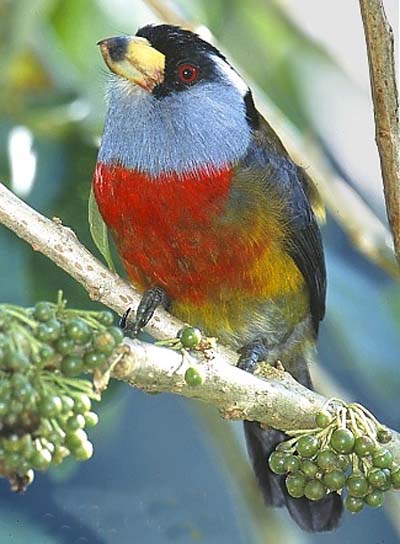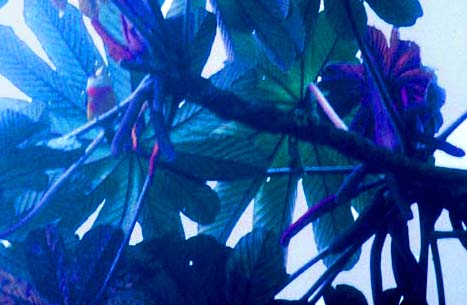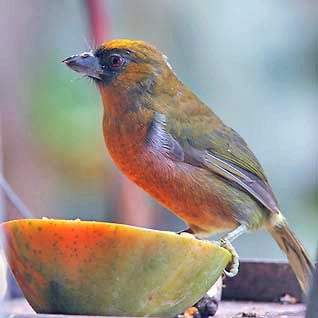| |
a web page by Don Roberson |
TOUCAN-BARBETS Semnornithidae |
- 2 species in the Neotropics
- DR personal total: 2 species 14%), 2 photo'd
|
 One of the prized birds in South America is Toucan-Barbet
(left; James Ownby took this gorgeous photo as it foraged in a fruiting
tree in the western Andes of Ecuador). Toucan-Barbet, found only in the
Andes of Colombia and Ecuador, is one of two species in the genus Semnornis;
the other is Prong-billed Barbet of Central America. Both of aberrant
Piciformes of uncertain affinities that have limited ranges in montane
cloud forests, and together they are known as (small case)
toucan-barbets. One of the prized birds in South America is Toucan-Barbet
(left; James Ownby took this gorgeous photo as it foraged in a fruiting
tree in the western Andes of Ecuador). Toucan-Barbet, found only in the
Andes of Colombia and Ecuador, is one of two species in the genus Semnornis;
the other is Prong-billed Barbet of Central America. Both of aberrant
Piciformes of uncertain affinities that have limited ranges in montane
cloud forests, and together they are known as (small case)
toucan-barbets.
Recent molecular evidence has
proven that New World barbets, toucans, and these two birds in
Semnornis (e.g., the toucan-barbets) are more closely related to each
other than they are to Old World barbets (Burton 1984, Prum 1988,
Sibley and Ahlquist 1990, Lanyon & Hall 1994, Barker & Lanyon
2000, Johansson et al. 2001, Johansson & Ericson 2003, Moyle 2004).
Given the evidence that toucans are actually 'big-billed New World
barbets' when compared to barbets in the Old World, there are several
different taxonomic approaches. The Handbook of the Birds of the World
(Short & Horne 2002) stuck with the traditional approach at the
time— two families: all the barbets (including these Toucan-Barbets) in
a barbet family and the toucans in a toucan family. Since then the
consensus is a five-family arrangement: three barbet families, the
toucans, and the toucan-barbets. This approach was taken by the South
American Checklist Committee, noting that "genetic data indicates that Semnornis
may be basal" to both Neotropical families (Barker and Lanyon 2000). In
short, to accurately represent the relationships of what used to the
Barbets and the Toucans, we now have five separate lineages and five
separate families, including the Toucan-Barbets [Semnornithidae]. They
are a special, unique, and highly sought group. |

My distant backlit photo (right) is how one more typically sees the Toucan-Barbet, high in the canopy of a Cecropia
canopy, where one glimpse just a touch of the brilliant reds &
yellows, offset by soft grays, that characterize its plumage. They love
fruiting trees — indeed, Remsen et al. (1993) found that 100% of the
stomach contents of both toucan-barbets was fruit. In this fruit-eating
behavior they are more similar to toucans than to New World Barbets. |
|  Both
species of toucan-barbets are unique among all barbet relatives in
having the bill tip extending forward and fitting into a notch in the
tip below. Young birds use these scissor-like tips to easily "bite"
their way out of nesting cavities (Short & Horne 2001). Both
species of toucan-barbets are unique among all barbet relatives in
having the bill tip extending forward and fitting into a notch in the
tip below. Young birds use these scissor-like tips to easily "bite"
their way out of nesting cavities (Short & Horne 2001).
This holds true for Prong-billed Barbet in
the mountains of Costa Rica and western Panama. It is not as colorful
as Toucan-Barbet but it does have the unique bill, as shown in this
photo from Costa Rica (left). |
Photos: Both photos of Toucan Barbet Semnornis ramphastrinus
were taken along the Nono-Mindo Rd., Ecuador. James Ownby photographed
his on 8 Apr 2002 at Septimo Paraiso Resort; my distant shot was higher
on the ridge and farther south along the road on 17 Apr 1992. The Prong-billed Barbet S. frantzii was at Mirador Cinchona, Costa Rica, on 18 Dec 2007. Photos are © James Ownby and Don Roberson, respectively; used with permission, all rights reserved.
Rating: 
Short, L.L., and J.F.M. Horne. 2001. Toucans, Barbets, and Honeyguides. Oxford Univ. Press, Oxford.
I
confess that I don't actually own this book, nor have I done more that
quickly glance through it in a bookstore. But every one of the Oxford
Univ. Press series on bird families has been excellent, and this looks
equally solid. I presume that the "meat" of this book has been
summarized by the same authors in their Handbook of the Birds of the
World series (Short & Horne 2002) which I do own and have studied.
Consistent with Oxford books in this series, the introductory material
is extensive and the species accounts thorough. Plates and
illustrations more than adequately enhance the text. If I have any
quibble, it is with the conservative approach to family level taxonomy
but, then again, this was written before the molecular studies by
Johansson et al. (2001) and Moyle (2004).
Literature cited:
- American Ornithologists' Union. 1998. Check-List of North American Birds. 7th ed. A.O.U., Washington, D.C.
- Barker,
F.K., and S.M. Lanyon. 2000. The impact of parsimony weighting schemes
on inferred relationships among toucans and Neotropical barbets (Aves:
Piciformes). Mol. Phylog. Evol. 15: 215-234.
- Burton,
P.J.K. 1984. Anatomy and evolution of the feeding apparatus in the
avian orders Coraciiformes and Piciformes. Bull. Brit. Mus. (Natural
History) 47: 331-441.
- Johansson, U.S., and P.
G.P. Ericson. 2003. Molecular support for a sister group relationship
between Pici and Glabulae (Piciformes sensu Wetmore 1960). J. Avian
Biology 34: 185-197.
- Johansson, U.S., T.J.
Parsons, M. Irestedt, and P.G.P. Ericson. 2001. Clades within "higher
land birds," evaluated by nuclear DNA sequences. J. Zool. Syst. Evol.
Research 39: 37-51
- Lanyon, S.M., and J.G. Hall. 1994. Re-examination of barbet monophyly using mitochondrial-DNA sequence data. Auk 111: 389-397.
- Moyle,
R.G. 2004. Phylogenetics of barbets (Aves: Piciformes) based on nuclear
and mitochondrial DNA sequence data. Mol. Phylog. Evol. 30: 187-200.
- Prum,
R.O. 1988. Phylogenetic interrelationships of the barbets (Aves:
Capitonidae) and toucans (Aves: Ramphastidae) based on morphology with
comparisons to DNA-DNA hybridization. Zool. J. Linnaean Soc. 92:
313-343.
- Remsen, J.V., Jr., M.A.
- Hyde, and A. Chapman. 1993. The diets of neotropical trogons, motmots, barbets and toucans. Condor 95: 178-192.
- Short, L.L., and J.F.M. Horne. 2002. Family Capitonidae (Barbets), pp. 140-219 in Del Hoyo, J. Elliott, A., & Sargatal, J. eds. Handbook of the Birds of the World. Lynx Edicions, Barcelona.
- Sibley, C.G., and J.E. Ahlquist. 1990. Phylogeny and Classification of Birds of the World. Yale Univ. Press, New Haven, CT.
|
|
|

 One of the prized birds in South America is Toucan-Barbet
(left; James Ownby took this gorgeous photo as it foraged in a fruiting
tree in the western Andes of Ecuador). Toucan-Barbet, found only in the
Andes of Colombia and Ecuador, is one of two species in the genus Semnornis;
the other is Prong-billed Barbet of Central America. Both of aberrant
Piciformes of uncertain affinities that have limited ranges in montane
cloud forests, and together they are known as (small case)
toucan-barbets.
One of the prized birds in South America is Toucan-Barbet
(left; James Ownby took this gorgeous photo as it foraged in a fruiting
tree in the western Andes of Ecuador). Toucan-Barbet, found only in the
Andes of Colombia and Ecuador, is one of two species in the genus Semnornis;
the other is Prong-billed Barbet of Central America. Both of aberrant
Piciformes of uncertain affinities that have limited ranges in montane
cloud forests, and together they are known as (small case)
toucan-barbets. 
 Both
species of toucan-barbets are unique among all barbet relatives in
having the bill tip extending forward and fitting into a notch in the
tip below. Young birds use these scissor-like tips to easily "bite"
their way out of nesting cavities (Short & Horne 2001).
Both
species of toucan-barbets are unique among all barbet relatives in
having the bill tip extending forward and fitting into a notch in the
tip below. Young birds use these scissor-like tips to easily "bite"
their way out of nesting cavities (Short & Horne 2001). 